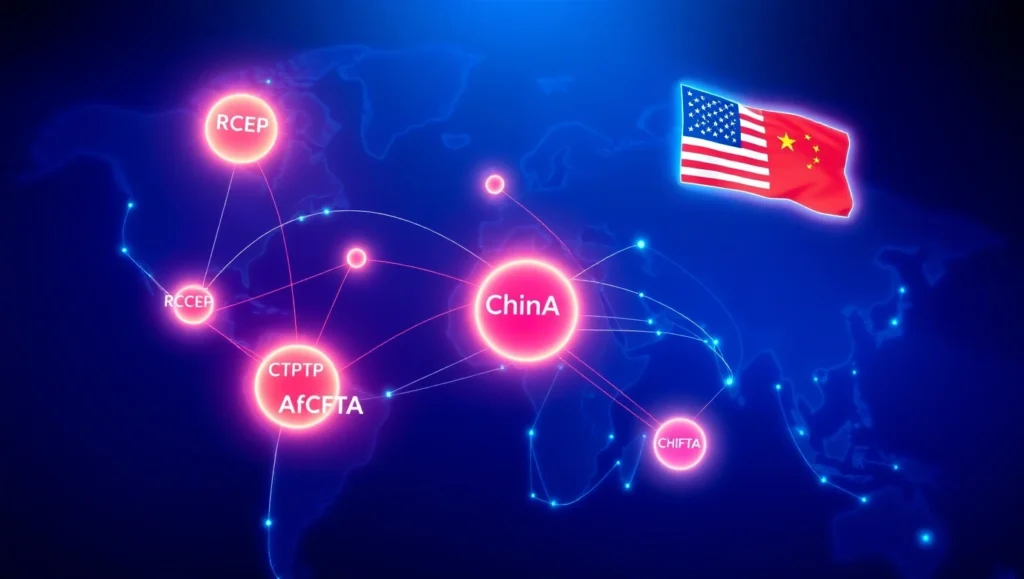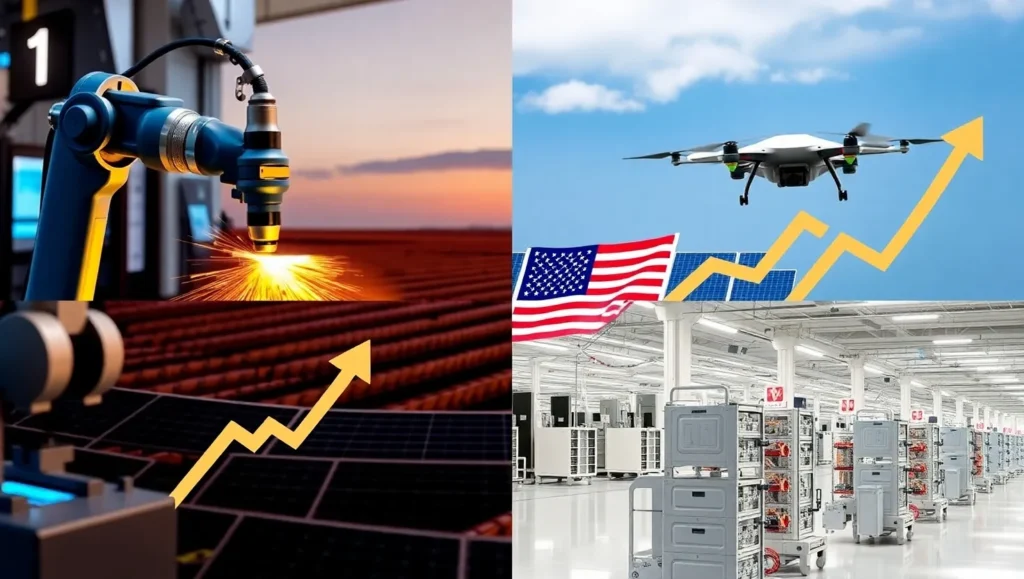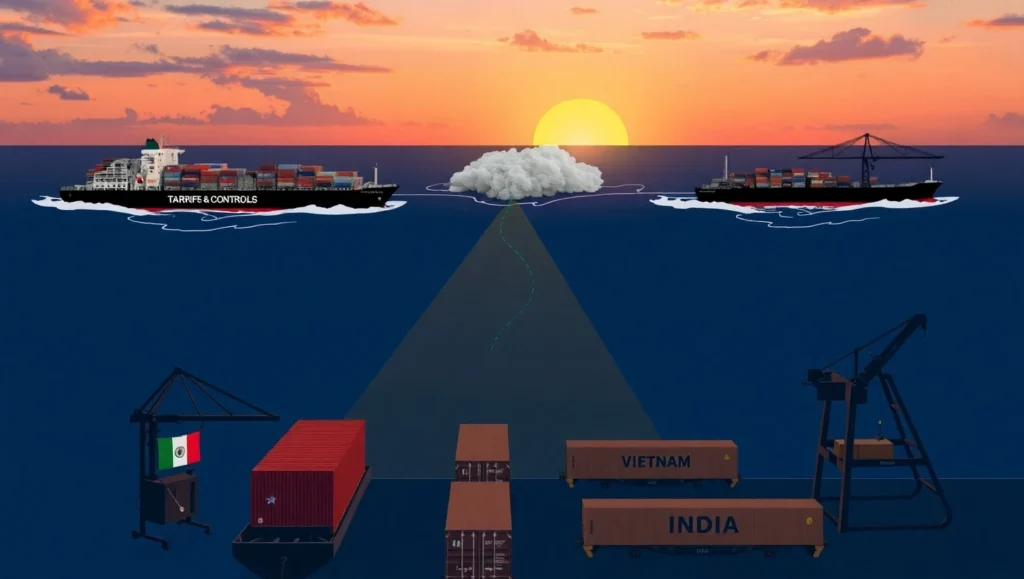Table of Contents
Introduction – US-China Trade War
US-China Trade War – Have you ever wondered how a clash between two economic titans could reshape the entire global landscape? 🌎💥 The ongoing US-China standoff isn’t just another political tussle—it’s a seismic shift that could trigger an unstoppable economic transformation.
As tensions simmer between these superpowers, the world watches with bated breath. But here’s the twist: this confrontation might just be the catalyst for unprecedented change and opportunity. From technological breakthroughs to shifting alliances, the ripple effects of this standoff are set to touch every corner of the globe—and your financial future could be hanging in the balance.
Buckle up as we dive into the heart of this economic showdown. We’ll explore the roots of this tension, uncover its far-reaching consequences, and most importantly, reveal how you can position yourself to ride the wave of this imminent transformation. From the birth of new industries to the reshaping of global partnerships, get ready to discover why this US-China face-off could be the key to unlocking a world of economic possibilities. 🔑💼

The Roots of US-China Economic Tension
Trade imbalances and tariff wars
The US-China economic tension stems largely from significant trade imbalances between the two nations. You’ll find that the US has consistently maintained a large trade deficit with China, importing far more goods than it exports. This imbalance has led to the implementation of tariffs by both countries, escalating into a full-blown trade war.
| Year | US Trade Deficit with China (in billions) |
|---|---|
| 2018 | $419.2 |
| 2019 | $345.2 |
| 2020 | $310.3 |
| 2021 | $355.3 |
| 2022 | $382.9 |
Technological competition and intellectual property disputes
You’ll notice that the race for technological supremacy has intensified the economic rivalry. China’s rapid technological advancements have raised concerns in the US about:
- Intellectual property theft
- Forced technology transfers
- Cybersecurity threats
- US-China Trade War
These issues have led to restrictions on Chinese tech companies and increased scrutiny of Chinese investments in US tech firms.
Currency manipulation accusations
Another point of contention you should be aware of is the accusation of currency manipulation. The US has repeatedly claimed that China artificially devalues its currency to gain an unfair trade advantage. This practice, if true, would make Chinese exports cheaper and more competitive in the global market.
Geopolitical power struggle
Ultimately, you’ll find that the economic tension between the US and China is part of a broader geopolitical power struggle. Both nations are vying for global influence, with economic policies serving as tools in this competition. This struggle extends beyond trade, encompassing areas such as:
- Military presence in the South China Sea
- Diplomatic influence in developing nations
- Control over critical resources and trade routes
- US-China Trade War
Now that you understand the roots of US-China economic tension, let’s explore how these issues have created ripple effects throughout the global economy.

Global Economic Ripple Effects
Supply chain disruptions
The US-China trade tensions have sent shockwaves through global supply chains, forcing businesses to adapt quickly. You’ll find that many companies are now diversifying their sourcing strategies to reduce reliance on a single country. This shift has led to:
- Increased production costs
- Longer lead times
- Reshoring of manufacturing
- Exploration of alternative suppliers
- US-China Trade War
Here’s a breakdown of the most affected industries:
| Industry | Impact Level | Primary Challenges |
|---|---|---|
| Electronics | High | Component shortages, increased prices |
| Automotive | High | Chip shortages, production delays |
| Textiles | Medium | Shifting production locations, higher costs |
| Agriculture | Medium | Changing export markets, price volatility |
Shifts in international trade patterns
You’ll notice significant changes in global trade flows as countries and businesses adjust to the new economic landscape. The US-China standoff has prompted:
- Increased trade between alternative partners
- Growth of regional trade agreements
- Rise of bilateral trade deals
- US-China Trade War
Impact on emerging markets
Emerging economies are experiencing both challenges and opportunities due to this economic transformation. You should be aware that:
- Some countries are benefiting from trade diversion
- Others are struggling with reduced foreign investment
- Currency fluctuations are affecting competitiveness
- Economic growth forecasts are being revised
- US-China Trade War
Changes in foreign direct investment flows
The economic tension is reshaping global investment patterns. You’ll observe:
- Reduced cross-border investments between the US and China
- Increased investment in alternative markets
- Rise of “friend-shoring” strategies
- Growing emphasis on domestic investment and self-reliance
- US-China Trade War
These shifts are creating new economic hotspots and altering the global financial landscape. As we move forward, it’s crucial to understand how these changes are influencing various sectors and regions of the world economy.

Catalyzing Innovation and Self-Reliance
Accelerated technological advancements
As tensions between the US and China escalate, you’ll witness an unprecedented surge in technological innovation. Both nations are racing to achieve self-reliance, particularly in critical sectors like semiconductors and artificial intelligence. This competition is driving rapid advancements, benefiting you as a consumer or business owner.
| Technology Area | US Focus | China Focus |
|---|---|---|
| Semiconductors | Advanced chip design | Domestic production |
| AI | Machine learning | Facial recognition |
| 5G | Network security | Infrastructure |
Domestic industry development
You’ll see a significant shift towards strengthening domestic industries. As supply chains become less reliable, countries are investing heavily in their own manufacturing capabilities. This trend offers you new opportunities for local business growth and employment.
Alternative energy and sustainability initiatives
The economic transformation is accelerating the adoption of green technologies. You’ll benefit from:
- Increased investment in renewable energy sources
- Development of more efficient electric vehicles
- Advancements in energy storage technologies
- Improved sustainability practices across industries
- US-China Trade War
Reshoring and nearshoring trends
As global supply chains face disruptions, you’ll notice a trend towards reshoring and nearshoring. Companies are moving production closer to home or to neighboring countries. This shift offers you:
- Shorter supply chains
- Reduced transportation costs
- Better quality control
- Increased job opportunities in local markets
- US-China Trade War
With these changes, you’re positioned to adapt and thrive in this new economic landscape. As we move forward, let’s explore how these developments are reshaping global economic alliances.

Reshaping Global Economic Alliances
Formation of new trade blocs
As the US-China standoff continues, you’ll notice a significant shift in global trade dynamics. New trade blocs are emerging, reshaping the economic landscape. These alliances are forming to counterbalance the economic power of the two giants and protect their interests.
| Trade Bloc | Key Members | Primary Objectives |
|---|---|---|
| RCEP | China, Japan, South Korea, Australia | Reduce tariffs, promote regional trade |
| CPTPP | Canada, Japan, Australia, Mexico | Enhance economic integration, set high standards |
| AFCFTA | 54 African countries | Boost intra-African trade, create single market |
Strengthening regional economic partnerships
You’ll see countries intensifying their efforts to strengthen regional ties. This strategy helps mitigate risks associated with over-reliance on either the US or China. For example:
- ASEAN nations are deepening their economic integration
- European Union is focusing on internal market resilience
- Latin American countries are exploring new regional cooperation models
- US-China Trade War
Diversification of international dependencies
To protect your interests in this changing landscape, consider diversifying your international dependencies. Countries and businesses are:
- Seeking alternative suppliers and markets
- Investing in domestic production capabilities
- Developing new trade routes and logistics networks
- Exploring partnerships with emerging economies
- US-China Trade War
Rise of alternative financial systems
You’ll witness the emergence of alternative financial systems challenging the dominance of traditional US-led institutions. These include:
- China’s Cross-Border Interbank Payment System (CIPS)
- Regional payment networks like INSTEX in Europe
- Digital currencies and blockchain-based financial solutions
- US-China Trade War
As we move forward, you’ll see how these reshaping alliances and systems create new opportunities for economic growth and resilience.

Opportunities in Economic Transformation
Emerging sectors and industries
As the US-China economic tension fuels transformation, new opportunities are emerging in various sectors. You’ll find growth potential in areas like renewable energy, advanced manufacturing, and digital technologies. Here’s a quick overview of promising industries:
| Sector | Growth Potential | Key Drivers |
|---|---|---|
| Green Technology | High | Climate change concerns, government incentives |
| AI and Machine Learning | Very High | Automation needs, data-driven decision making |
| Cybersecurity | High | Increased digital threats, remote work trends |
| Biotechnology | High | Aging population, personalized medicine |
Job creation in new fields
You’ll witness a shift in the job market as these emerging sectors gain traction. New roles are being created, requiring a blend of technical and soft skills. Some of the most in-demand jobs include:
- Data scientists and AI specialists
- Renewable energy technicians
- Cybersecurity analysts
- Biotechnology researchers
- US-China Trade War
Increased focus on economic resilience
The ongoing economic tensions have highlighted the importance of building resilient economies. You’ll see governments and businesses alike prioritizing:
- Diversification of supply chains
- Investment in domestic production capabilities
- Development of strategic reserves for critical resources
- Enhancement of digital infrastructure
- US-China Trade War
Potential for more balanced global growth
As economies adapt to the new landscape, you’ll observe a more distributed pattern of global growth. Emerging markets may benefit from:
- Increased foreign investment as companies seek alternative manufacturing hubs
- Development of local innovations to meet specific regional needs
- Greater participation in global value chains
- US-China Trade War
With these changes, you’re poised to witness a significant shift in the global economic landscape, presenting both challenges and opportunities for businesses and individuals alike.

Conclusion – US-China Trade War
The US-China economic standoff is more than just a conflict between two superpowers; it’s a catalyst for global economic transformation. As tensions rise, you’re witnessing a shift that’s reshaping international trade, spurring innovation, and forging new alliances. This economic upheaval presents both challenges and opportunities for businesses and nations alike.
As you navigate this evolving landscape, remember that adaptability is key. Whether you’re an entrepreneur, investor, or policymaker, staying informed and agile can help you turn these global shifts into advantages. Embrace the change, seek out new opportunities, and be prepared to innovate. The economic transformation triggered by the US-China standoff could be your springboard to unprecedented growth and success in the emerging global economy.
Frequently Asked Questions (FAQ’s) About US-China Trade War
What exactly is the “US‑China standoff”?
It refers to the escalating economic, technological, and geopolitical rivalry between the United States and China, characterized by tariffs, export controls, investment restrictions, and strategic competition in areas like AI and 5G.
Why does this standoff matter for the global economy?
Because both countries are economic powerhouses whose policies ripple through global supply chains, trade flows, investment patterns, and innovation ecosystems—impacting businesses, consumers, and governments worldwide.
How did trade imbalances fuel the tension?
Persistent US trade deficits with China led to American tariffs on hundreds of billions in Chinese goods, prompting retaliatory levies and a broader “trade war” that disrupted flows of electronics, machinery, and consumer goods.
What role have tariffs played in this conflict?
Tariffs raised costs for importers and consumers on both sides, encouraged companies to seek alternative suppliers, and accelerated discussions around reshoring and supply‑chain diversification.
US-China Trade War
Why is technological competition such a flashpoint?
The race for leadership in semiconductors, artificial intelligence, and next‑gen telecom is seen as vital to national security and economic leadership—leading to export controls on chips, blacklisting of key firms, and incentives for domestic R&D.
How do tariffs impact consumers in both the US and China?
Tariffs often lead to increased prices for consumers, as importers pass on the additional costs. In the US, this can make everyday items like electronics and clothing more expensive, while in China, tariffs on agricultural products can raise food prices.
What are the potential long-term effects of the trade war on global economic growth?
Prolonged trade tensions can slow global economic growth by disrupting supply chains, reducing business investments, and increasing market volatility. The uncertainty can deter companies from expanding, leading to decreased economic activity worldwide.
What intellectual property (IP) disputes are at issue?
The US accuses China of IP theft, forced tech transfers, and unfair licensing terms—while China argues the US restricts its firms’ access to technology. This tension has prompted stricter scrutiny of joint ventures and cross‑border M&A.
US-China Trade War
How do currency concerns factor in?
Washington has periodically accused Beijing of devaluing the yuan to make Chinese exports cheaper—though the People’s Bank of China maintains its interventions are limited and aimed at stability.
Is this just about economics?
No—the standoff is also a geopolitical power struggle over influence in Asia, Africa, and beyond, with trade policy used as a lever alongside military posturing and diplomatic initiatives.
How have supply‑chain dynamics changed?
Companies have accelerated efforts to “de‑risk” by diversifying suppliers, moving production to Southeast Asia or back home, and building buffer inventories to guard against sudden policy shifts.
Which industries feel the impact most acutely?
Electronics and automotive (due to chips), textiles (shifting factories), agriculture (tariff‑driven market changes), and pharmaceuticals (raw‑material sourcing) have all seen significant cost and timing pressures.
How are other countries responding to the US-China trade war?
Many countries are seeking to mitigate the impact by negotiating new trade agreements, adjusting their own tariff policies, or positioning themselves as alternative markets and manufacturing hubs to attract businesses looking to diversify their supply chains.
US-China Trade War
What new trade patterns are emerging?
We’re seeing surges in US–Mexico trade, booming commerce among ASEAN nations, and deepening ties between China and Belt‑and‑Road partners—reshaping traditional North–South and East–West corridors.
How are emerging markets affected?
Some benefit from “trade diversion” as firms relocate; others struggle with reduced Chinese or American investment. Currency volatility also complicates borrowing and export competitiveness.
What’s happening with foreign direct investment (FDI)?
Cross‑border deals between the US and China have slowed sharply, while investments are flowing into India, Vietnam, Mexico, and other “friend‑shoring” destinations.
US-China Trade War
Could this rivalry actually accelerate innovation?
Yes—both governments are pouring resources into chip fabs, AI labs, and quantum research to reduce reliance on the other, spurring breakthroughs that eventually diffuse globally.
What domestic‑industry trends should we watch?
Expect heavy growth in local semiconductor manufacturing, cloud‑computing infrastructure, clean‑energy production, and biotech hubs as nations aim for strategic self‑sufficiency.
What role does the World Trade Organization (WTO) play in the US-China trade dispute?
The WTO serves as a forum for negotiating trade agreements and resolving disputes. Both the US and China have brought complaints against each other to the WTO, seeking rulings on the legality of the imposed tariffs and trade practices.
US-China Trade War
How is sustainability affected?
The push for energy security and resilience dovetails with green goals—driving solar, wind, EV, and battery‑storage investments in the US, China, and partner countries alike.
Why are companies reshoring or nearshoring?
To shorten supply lines, improve quality control, and avoid tariff exposure—often relocating factories from China to Mexico, Eastern Europe, or even back to the US.
What new trade alliances are forming?
Regional pacts like RCEP in Asia, the CPTPP in the Pacific, and the African Continental Free Trade Area are gaining traction as countries hedge between Washington and Beijing.
How can businesses diversify their dependencies?
By mapping their full supply chains, qualifying multiple suppliers across regions, investing in local production, and exploring digital platforms for risk monitoring.
US-China Trade War
How can individuals and investors position themselves?
Stay informed on policy shifts and regional developments.
• Look for growth in “de‑risking” sectors—semiconductors, renewables, cybersecurity, and supply‑chain software.
• Consider geographic diversification in portfolios (e.g., emerging markets benefiting from trade realignments).
• Embrace lifelong learning to adapt skills for high‑growth industries like AI, green tech, and advanced manufacturing.
Could the trade war lead to a decoupling of the US and Chinese economies?
There’s potential for partial decoupling, especially in strategic sectors like technology. Both nations are encouraging domestic production and reducing reliance on each other, which could lead to more segmented global markets and less economic interdependence.
US-China Trade War

3 thoughts on “Why the US-China Trade War Could Fuel Unstoppable Economic Transformation 2025 🔥🌍”